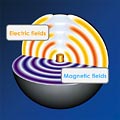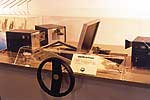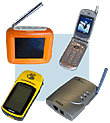


 Radio Wave Wall
Radio Wave Wall


 The function of the radio wave is explained through a video and an interactive display.
The function of the radio wave is explained through a video and an interactive display.
What are radio waves? We use radio waves every day.
What exactly are radio waves? How do unseen radio waves travel through the air? Revealing the mystery of radio waves on the radio wave wall.


 Radio waves
Radio waves
What are radio waves? We cannot see radio waves, but they fill the air surrounding us.
Radio waves are a type of electromagnetic wave, just like light.
Electromagnetic waves exist in electric fields, which are created by electricity, and magnetic fields, which are created by magnets.
They exchange energy and are carried through the air as waves.
Electromagnetic waves travel in straight lines at a speed of 300,000km per second.
This means that they can travel around the earth 7.5 times in one second.
Although radio waves are invisible, they exist all around us. The function of the invisible radio wave is introduced with the help of 3D animation.


 Sending and receiving radio waves
Sending and receiving radio waves
The sending and receiving of radio waves is conducted through the air.
A transmitter is used to generate radio waves and a transmission antenna is used to send them out through the air.
A reception antenna picks up radio waves that are in the air at the receiving end and amplifies them for use.
There are many radio waves passing through the atmosphere, but specific waves can be picked up by tuning to their frequency.
By using the same frequency at the locations of transmission and reception, radio waves can be transmitted without interference.


 The nature of radio waves
The nature of radio waves
Radio waves are waves that travel through the air, but what happens when there are obstacles?
For example, many radio waves can pass through planks of wood. However, radio waves cannot pass through metals as they are reflected.
In other words, they are unable to pass through to the other side of a metal object.
Radio waves are affected by obstacles by either being allowed to pass through them or by reflecting off them. By observing these characteristics, we can tell what kind of objects are in a radio wave's path.

This display provides firsthand knowledge of the transmission and reception of radio waves. You can actually observe the characteristics of a radio wave as it passes through a wooden board but is reflected off a piece of metal.

 A representation of radio waves and light:
A representation of radio waves and light:
an electromagnetic wave spectrum
The Okinawa Electromagnetic Technology Center monitors the movement of
the earth's air and oceans through the use of radio waves. What are radio
waves? The basic function of radio waves is introduced through a video
and an interactive display. The large wall in the rear is called an electromagnetic
wave spectrum, which is a kind of map introducing radio waves and light
and how they are utilized.
 Units of electromagnetic waves and the electromagnetic wave spectrum
Units of electromagnetic waves and the electromagnetic wave spectrum
An electromagnetic wave is measured by frequency and wavelength as it fluctuates.
The unit for how many times the wave peaks in one second (its oscillation frequency) is hertz (Hz).
The unit for the distance between the wave peaks (the wavelength) is standard meters (m).
Wavelength and frequency are inversely proportional.
Multiplying the frequency of a wave by its wavelength will give its velocity.
The velocity of any given radio wave is 300,000km per second so, for example, the frequency of a wave with a 3m
wavelength (such as the one for TV Channel 2) will be 100 million hertz.
The names of various frequencies of electromagnetic waves and their essential uses are displayed in an
electromagnetic wave spectrum on the face of this wall.



 Familiar radio waves
Familiar radio waves
We use radio waves every day. Watching the news on TV, listening to music on the radio and talking to friends on cellular phones all involve the use of radio waves.
By using radio waves we are able to transmit information to places that are far away and to people who are moving.
Furthermore, we can examine objects that are in a far-away location by using radio waves. By using radio waves in the form of radar, it is possible look at the conditions within clouds and to examine the flow of water in the sea.
At the Okinawa Electromagnetic Technology Center, we are researching and
developing technology that allows us to use radio waves to examine the
atmosphere and the ocean.